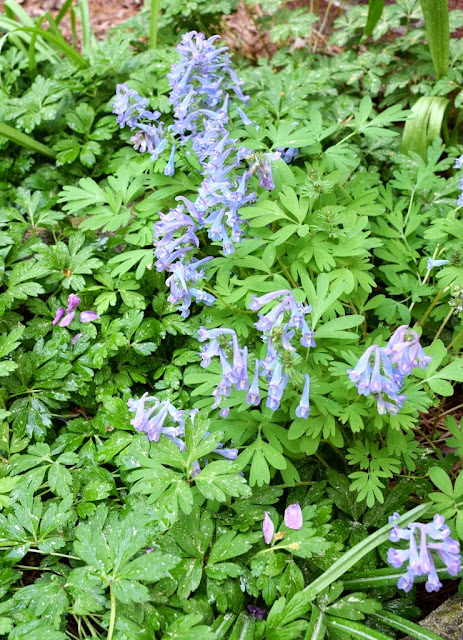 |
Corydalis turtschaninovii |
It seemed to grow in all manner of spots: sunny, shady, among other plants, and by itself. In gravelly soil and woodsy soil. Of course--as soon as I could, I Googled it and discovered it's a popular Chinese medicine: so I hate to think of how many of these are consumed each year by organs other than the eyes. Doesn't seem right in my opinion!
Many of us find ourselves growing more and more corydalis in all shades of yellow, pink, rose, nearly red and purples of course. Decades ago we would obtain "Corydalis ambigua" from Japan which shares the heavenly blue color of this waif, but lacks it's durability and staying power in the garden. And yes, there are a positive truckload of Chinese species of the "flexuosa" persuasion that have piercing cobalt or azure flowers for a long season in summer. Though these are more accommodating than the spectacular Corydalis cashmeriana one sees in Scottish and Swedish gardens (where it's sufficiently cool for it to thrive) they do need to be divided frequently, and insist on fertile, fluffy soils to settle down for their performance...In hot summer regions this performance is often brief and temporary. Not so, apparently, for our Chinese medicinal blue one!
Each time I turn the corner, another monstrous clump. And that blue!
Unfortunately, we are now going to all have to memorize the spelling of the accursed turtschaninovii: why couldn't it have been named for some crisp, monosyllabic Anglo Saxon instead? Although I'm one to talk with my name.
But when you look at these graceful azure flowered nymphs curtseying here and there all over the garden, it will be worth it don't you think? Easily and quickly grown from seed as well as division: I dare say we'll be seeing a lot more of this outside the Thompson garden in the coming years!









I like your name. It is your brand. It is distinctive. People know it through out the plant world. People would buy plants just because it had your name on it.
ReplyDeleteThis comment has been removed by the author.
ReplyDeleteJust wait until we get the real C. panda here in the states! Easy name, and the blue almost (almost) rivals that of Penstemon scariosus var. cyanomontanus.
ReplyDelete[Scratch that. The plant I have in mind may have been a form of P. virens or a related species, which I found on a flat along the Laramie River a few years ago. I think I vouchered it...]
Delete